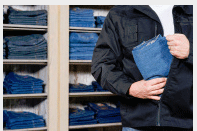 Throughout the last few years, I’ve encountered and had the chance to network with several small business owners in my community. Most of these encounters were a part of a retail/law enforcement partnership. It always seems that these smaller stores have the same shoplifting problems as the big box retailers, but with one key difference. Those small stores don’t have the sales figures to cushion them from losses. If I compared my store (a large national retailer) to a smaller store in the same shopping center, and that smaller store has even ¼ the loss I see, that could be devastating to their ongoing success. Part of the problem is that smaller stores are less likely to prosecute a shoplifter, which makes them a very soft target.
Throughout the last few years, I’ve encountered and had the chance to network with several small business owners in my community. Most of these encounters were a part of a retail/law enforcement partnership. It always seems that these smaller stores have the same shoplifting problems as the big box retailers, but with one key difference. Those small stores don’t have the sales figures to cushion them from losses. If I compared my store (a large national retailer) to a smaller store in the same shopping center, and that smaller store has even ¼ the loss I see, that could be devastating to their ongoing success. Part of the problem is that smaller stores are less likely to prosecute a shoplifter, which makes them a very soft target.
The case for prosecuting every shoplifter is strong. You can look at every major retailer across the country and they all have large Loss Prevention departments with the goal of prosecuting everyone that steals from them to the fullest extent of the law. Why do they do this, and better yet, why should you? First, it sends a very clear message. You will not tolerate stealing your hard-earned money, and if you come in my store and steal, you will go to jail. Second, it keeps prices low for your customers, and shrink low for you. Finally, if someone steals from you and damages your product, even if you recover it, you’re still at a loss. By prosecuting that shoplifter, you are entitled to recover what has been lost during that particular incident.
It’s important to send a message to shoplifters. Believe me when I tell you that shoplifters share trade secrets. Not only does word travel on the new item to boost, but where the easiest place to steal it is. Shoplifters are like water, they travel the path of least resistance. If they know that the small store up the road won’t call the cops if they are caught, then that’s where they are going. It’s basically a win-win for the thief. They can either come into your store, steal and get away, or they can get caught with no real consequence and be released only to try again. You have to take a stand against their criminal acts and show them that you will not be victimized by their actions. Money:
We all like to boast our low prices. You can’t have a successful business if your prices are significantly higher than your competitors. Well, shoplifting affects your ability to keep prices low. If you are logging loss month, after month, you’re going to have to raise your prices in order to make up for the losses. This may help in the short term, but over time, customers will seek out the best deal for their dollar. Prosecuting a shoplifter keeps that merchandise in your store, it keeps the product available for your customer and it ensures that you stay in the black.
Money: You’re in business to make money. When a shoplifter steals from you, they are taking money out of your pocket, and food off of your family’s table. Let’s imagine a shoplifter steals a pack of steaks from you. Maybe they put the food down their pants, but you catch them at the door and get your steak back. Would you really put that food back out for sale? Probably not. If you didn’t file charges against that shoplifter, he was able to still cause a loss to your store. By prosecuting this individual, you will be able to collect, through the court system, what is rightfully owed to you. You wouldn’t allow someone to come into your home and steal your TV with no consequence, so why let them do it to your business?
Every time I have the chance, I bring up these points to whomever will listen to me. What I see the most is small business owners being afraid to prosecute a thief for various reasons. The most common is the reluctance to go through the judicial process. I know… the wheels of justice turn very slowly these days, but that’s no excuse to let a thief go un-punished. Your business is your life blood, it’s how you feed and provide for your family, so next time you catch that shoplifter stealing your hard earned money, make sure that they are prosecuted to the fullest extent of the law.





